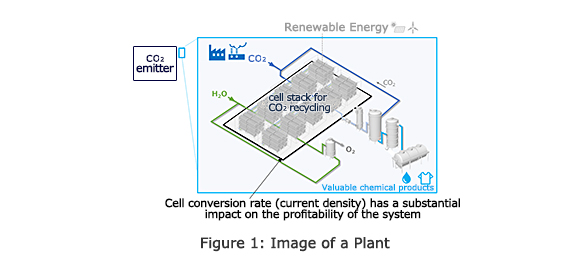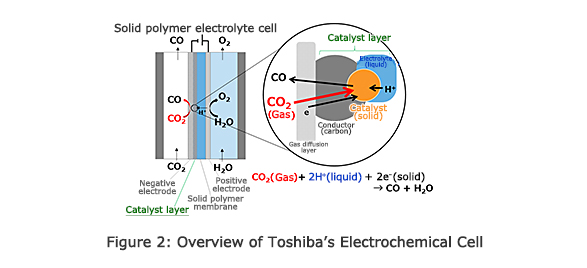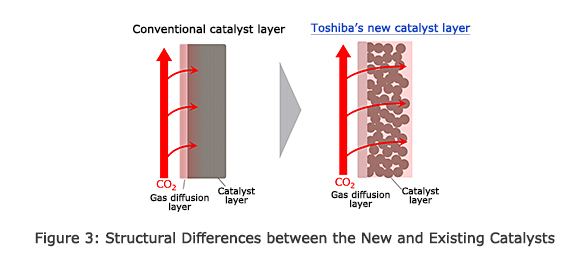Toshiba Leads the World in Converting CO2 into Useful Materials for Chemical Products
-New Technology Reduces CO2 Emissions, Can Contribute to Achieving Paris Agreement Targets-
Toshiba Corporation
TOKYO─Toshiba Corporation (TOKYO: 6502) has developed CO2 conversion technology(Note 1) with the world's highest level of conversion efficiency, approximately 450 times higher than that of the company's current technology. At a time when many countries face the urgent challenge of reducing CO2 emissions to meet the targets of the Paris Agreement, Toshiba's new solution is a highly promising advance in respect of operating efficiency, space requirements and low cost. Going forward Toshiba aims to develop commercial systems based on the technology by the latter half of the 2020s.
The conversion technology uses a proprietary electrocatalyst electrode that converts CO2 collected from factories and other industrial facilities into carbon monoxide, a raw material for plastics, paints, pharmaceuticals, and fuel. Details will be presented at the 99th Annual Meeting of the Chemical Society of Japan in Kobe from March 16-19.
Increasing atmospheric levels of CO2 are widely understood to be a major cause of climate change,(Note 2) and efforts of recent years, including the SDGs(Note 3) and ESG investment,(Note 4) demonstrate growing awareness of the urgent need for decarbonization in the economic and industrial sectors. However, Japanese industry's lack of progress in reducing CO2 emissions is holding back the country's efforts to achieve its Paris Agreement target-an 80% reduction of greenhouse gas emissions by 2050. The development of technologies that use electrochemical reactions─chemical reactions involving electricity-to convert CO2 into useful substances is taking place against this backdrop.
Chemical reactions on the surfaces of positive and negative electrodes in electrochemical cells convert CO2 into useful substances that serve as resources. In a previous technological development, different types of renewable energy dispersed throughout the power grid were used as power sources to apply power to electrochemical cells, which then converted CO2 dissolved in aqueous solutions into useful substances. However, the small amount of CO2 that can be dissolved in aqueous solutions limits the conversion of CO2, which suppresses current density (an indicator of the speed of electrochemical reactions).(Note 5) One way to accelerate the conversion and increase output is to use more electrochemical cells, but space and cost constraints limit that approach. For the technology to be practical, current density and output must be increased while taking steps to save space and cut costs.
To solve this problem by substantially increasing current density, Toshiba developed an electrocatalyst electrode specifically to remove the need to dissolve CO2 gas in water before starting the reaction. The electrocatalyst electrode enables reactions at the three-phase boundary between a solid (the catalyst), a gas (CO2), and a liquid (water); here, CO2 gas and water react with each other as they interact with the electrocatalyst. This ability to use CO2 in its gaseous state accelerates its transformation and removes the limits on current density.
In addition, the catalyst layer features nanopores as well as macropores that direct the flow of CO2 gas. This distinct structure limits the diffusion resistance of the gas, which enables more of it to react with the catalyst. This results in the production of carbon monoxide at a Faraday efficiency*6 of 92% at a current density of 700mA/cm2─a high conversion rate─under normal conditions (ambient temperature and pressure). This is higher than any other technology in the world, and roughly 450 times higher than Toshiba's previous technology.
The new technology's conversion system also requires less space for installation and is less expensive than present technologies. In the future, it will be possible to reduce CO2 emissions by installing the systems adjacent to thermal power plants, industrial facilities, and other major emitters of CO2, and using solar power, wind power, and other renewable energy to power them.
Toshiba intends to continue to test and verify the new technology's conversion system and build a model of a carbon-circulating society as part of the Japanese Ministry of the Environment's model project for CO2 resource recovery using artificial photosynthesis technology. Toshiba aims to commercialize the new technology in the second half of the 2020s.



- (Note 1)
- Source: Toshiba survey, March 2019.
- (Note 2)
- Comprehensive Report on the IPCC Fourth Assessment Report, Ministry of the Environment.
- (Note 3)
- The abbreviation for the Sustainable Development Goals, adopted at the 2015 United Nations Sustainable Development Summit.
- (Note 4)
- Targeted investment in companies sensitive to environmental, social, and governance matters.
- (Note 5)
- The current value per cross-sectional unit of electric current, used to express the speed of electrochemical reactions.
- (Note 6)
- A ratio that expresses how much electricity is applied to the target electrochemical reaction.
Introductory video and past press releases of related technology
Video
* Click Play button to start movie. YouTube is the service provided from other company, and please follow the terms of use in YouTube.


